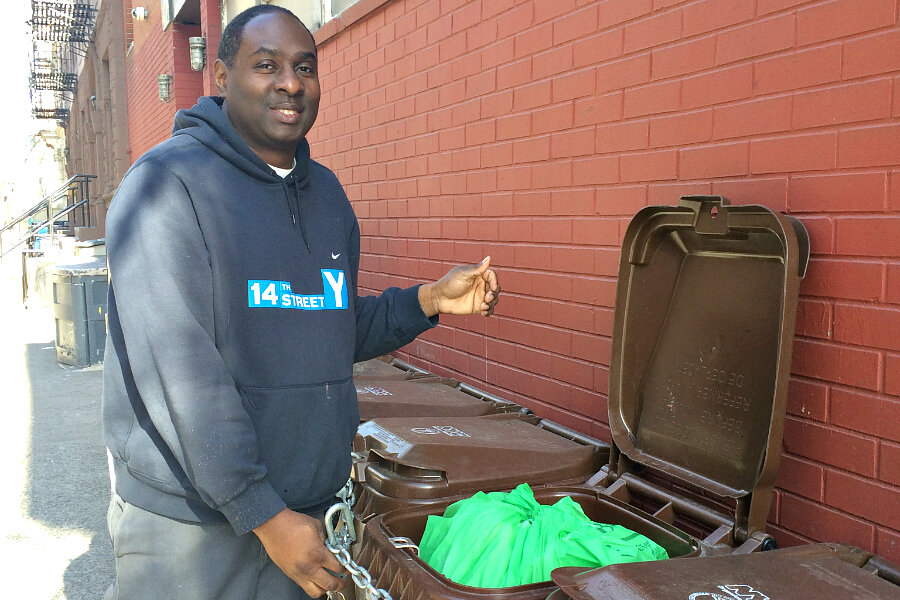Composting made easy wins over New Yorkers
Loading...
| New York
As she enters the 14th Street Y in New York City Wendy Seligson makes a beeline for the black bin standing in the lobby. She pulls out a neatly sealed plastic bag filled with lemon peels, salad bits, and carrots.
It’s not her lunch. It’s her contribution to the center’s pilot composting program.
“It’s another connection to the community. Greening is really important to us,” says Ms. Seligson, the Y’s associate executive director.
Open to members and non-members alike, the Y’s composting program accepts a wider variety of items – meat and dairy, bones and cheese, shells and paper – than most city composting operations – or backyard compost bins.
“Composting is the sexiest thing we’ve done so far,” says Camille Diamond, the Y’s director of community engagement and communications. “We’ve had energy audits, changed light bulbs. While that’s important it doesn’t hit the same button.
"A lot of us here feel with this program we are creating a future for our children.”
In that sense the program, located in New York's East Village, embodies a core Jewish value: People are stewards of the earth and have a responsibility to leave the world a better place for future generations. The program also recognizes the need for city dwellers to compost as landfill space runs out and disposal fees for garbage increase.
New Yorkers produce about 12,000 tons of waste a day. About one-third of that is organic waste, including food scraps and food-soiled paper, according a 2014 New York City Department of Sanitation report.
Composting diverts food scraps from overcrowded landfills. It returns nutrient-rich food scraps back to the soil and helps reduce methane gas in the atmosphere. It can also generate renewable energy to fuel homes or vehicles.
The Y hopes its two-year-old program will encourage other institutions to start similar efforts to provide residential drop-off composting, says Ms. Diamond, who runs the Y's program.
The Y also uses its composting program as an educational tool. At its Staten Island summer camp children learn what a landfill is, what compost is, and what type of refuse belongs where. They learn that eggshells and apple cores are not garbage but potentially valuable compost.
The program collects about 2,000 pounds of compost a month from 14th Street Y members and non-members.
About 180 member households signed up for the program. However, based on the amount of compost coming into the building, Diamond estimates that at least 300 member households are participating.
“At home we fill up our milk cartons, which are compostable, with food scraps, and I bring them here,” says Diamond, who participates in the program herself.
Convenience has been a key to making the program successful.
People can drop off their food scraps seven days a week, between 6 a.m. and 10 p.m. on weekdays and 7 a.m. and 9 p.m. on weekends. There is no charge to drop off. There is also no limit to the frequency or amount of items one can drop off.
Andrew Winter changes the green bio bag in the lobby about four times a day. He brings the filled bag, which is made from corn and is entirely compostable, to one of six locked bins behind the brown brick building.
Soon a city sanitation truck will roll to a stop and collect the food scraps for free. It will transport them to a commercial composting facility in Delaware. There the scraps are put into aerated piles where they are broken down into valuable compost. The city then sells the compost to farmers for use in fertilizing their fields.
The center’s program is part of a citywide effort to increase composting. Composting workshops are available in all five boroughs. Interested New Yorkers can learn about indoor and outdoor composting as well as sustainable gardening.
“When it came to doing things to be green, we never wanted to get preachy about it,” Diamond says. “We just wanted people to see how easy it is to participate.”







